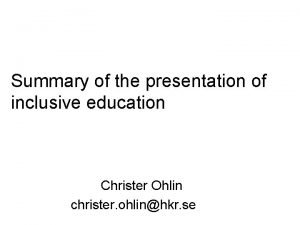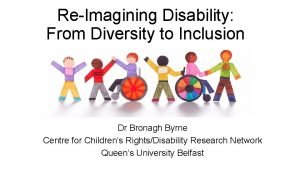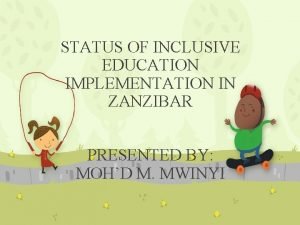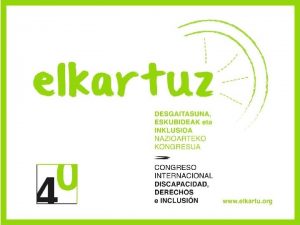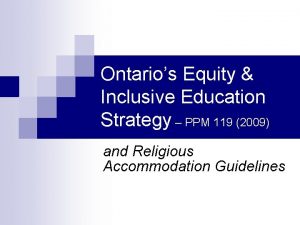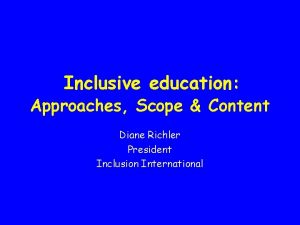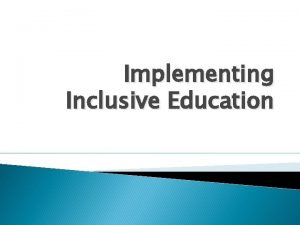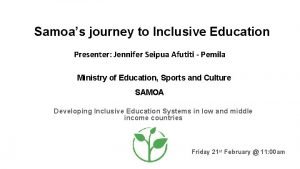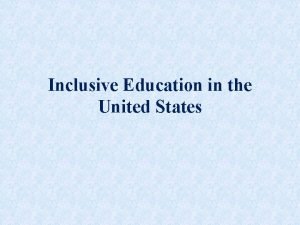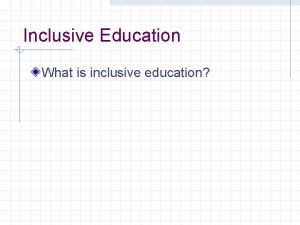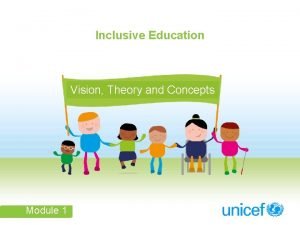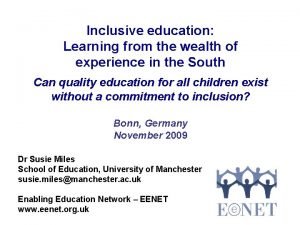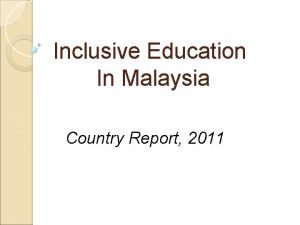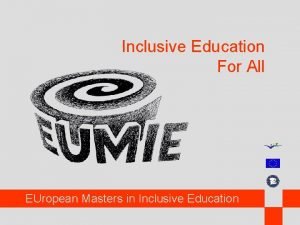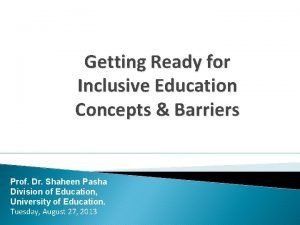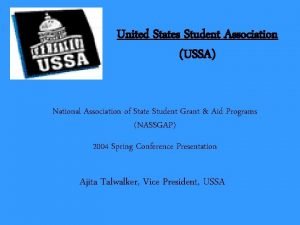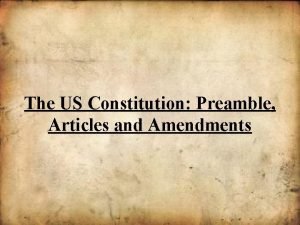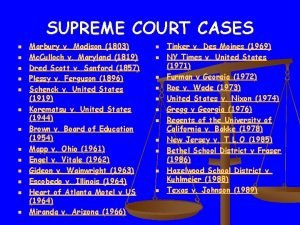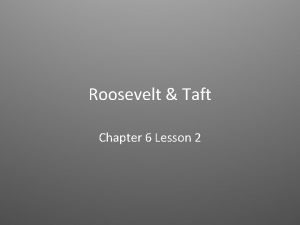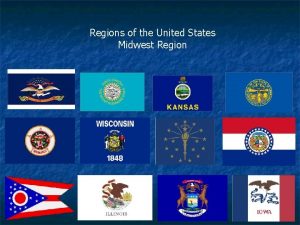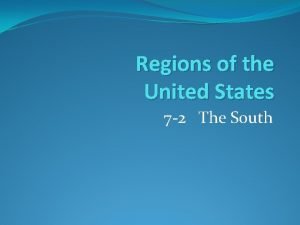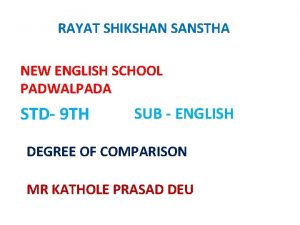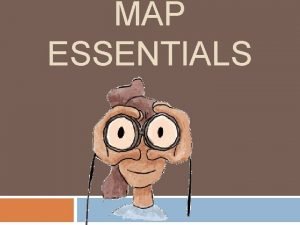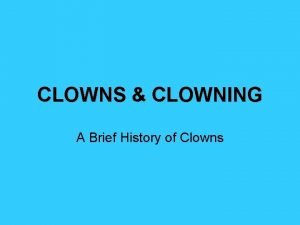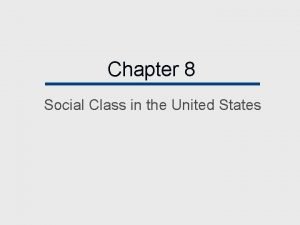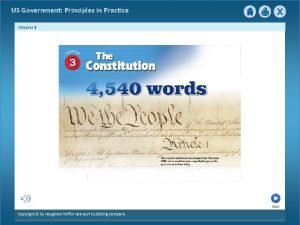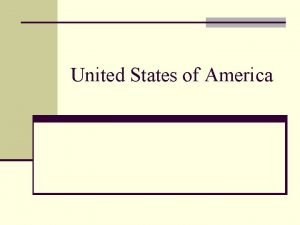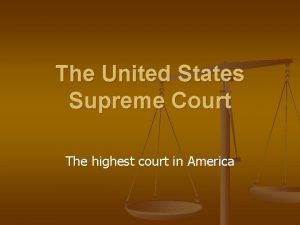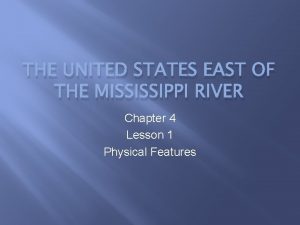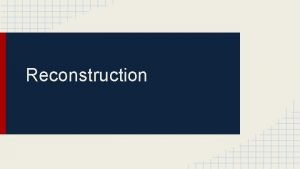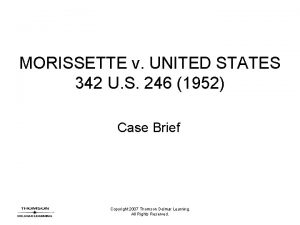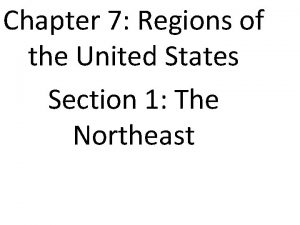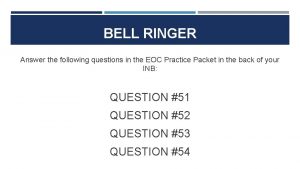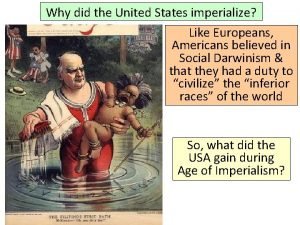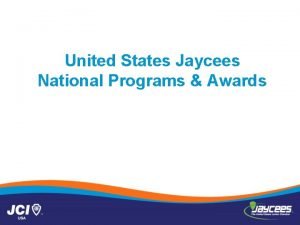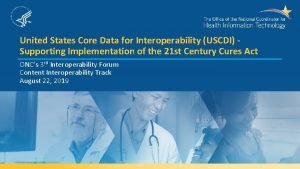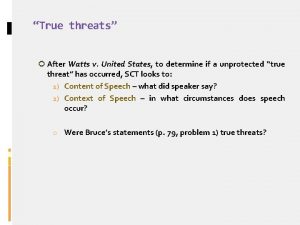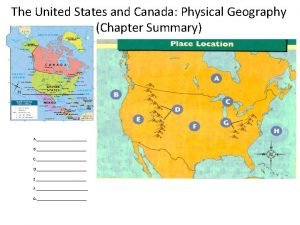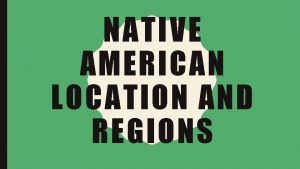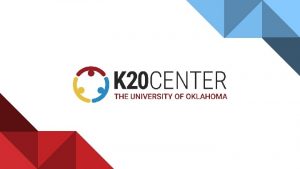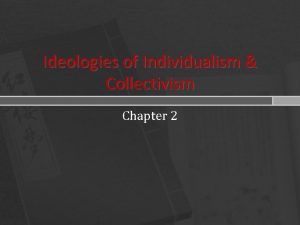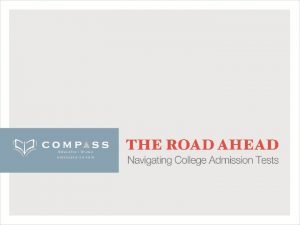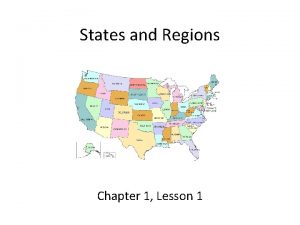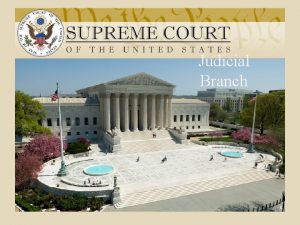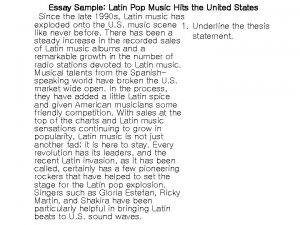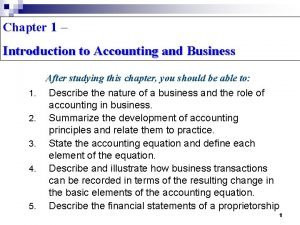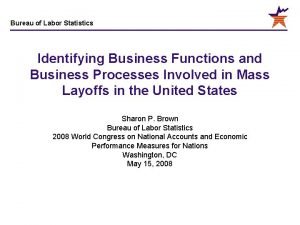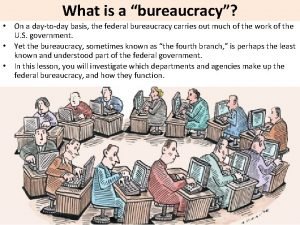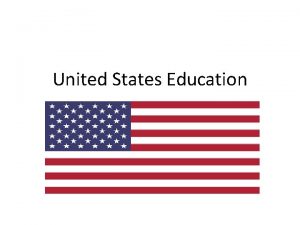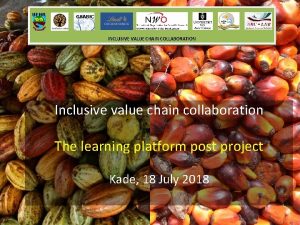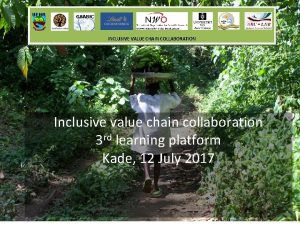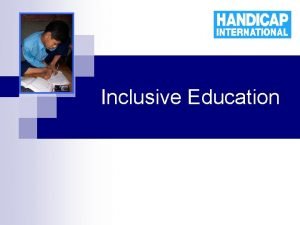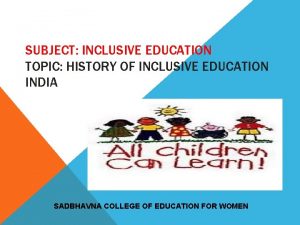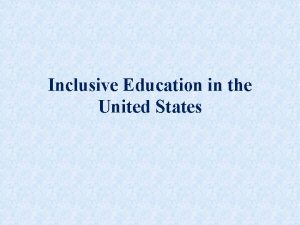Inclusive Education in the United States When a






























































































- Slides: 94

Inclusive Education in the United States

When a student is not learning, it’s a teacher problem, not a student problem. —Robert Heiny

Background • America has a dark and tragic history in special education. • Before the 1970 s, American children with disabilities were either educated is special schools or were not allowed to go to school at all. • Student with disabilities had no rights. • The aim of this tragic story is show that positive change is possible, even under difficult circumstances.

Willowbrook State School Stanton Island, New York






Conditions at Willowbrook were terrible: • Children and residents at Willowbrook were – Neglected – chained to their beds – locked up in small, dark rooms with no contact with others – laying on the floors in filth – physically abused – Due to the terrible conditions, screaming and crying was continual.

• Willowbrook was over-crowded and filled many times beyond it’s legal capacity. • It was basically a warehouse for storing unwanted children with disabilities. • There were often no toothbrushes or toilet paper. • It was very dirty, filthy. • “It smelled of filth. It smelled of disease and it smelled of death. ” – journalist Geraldo Rivera • Children were deliberately exposed to hepatitis. Doctors injected the deadly virus directly into their bodies with needles to study effects of the disease.

A General Trend • Willowbrook was part of a general trend in the U. S. . It was not the only “school” for students with disabilities that had these terrible conditions. • This was common in other institutions for individuals with disabilities. • Sadly, many educators simply didn’t care about students with special needs. • Tragically, some children in these institutions were misdiagnosed and did not have cognitive disabilities.

Social Change • Beginning in the 1950 s and continuing through the early 1970 s, a series of events, court cases, and legislative laws made illegal the educational isolation of children with disabilities.

Anger • Geraldo Rivera publically exposed the abusive and neglectful conditions at Willowbrook. • Public anger at the inhuman and terrible conditions institutions such as New York's Willowbrook School and other institutions began a change in society’s attitudes, beliefs and practices.

Civil Rights Movement (1950 s and 60 s) • During the Civil Rights Movement, people fought for the rights all people to vote, receive an appropriate education, and participate fully in society regardless of racial background. • The civil rights movement encouraged people to also fight for the rights of individuals with disabilities. • The courage of early civil rights advocates gave others courage to fight for civil rights for children and adults with disabilities.



Protests • During the 1960 s and 70 s there were many protests by individuals with disabilities. • Individuals with disabilities fought for the right to have jobs, ride public transportation and live independently. • People also fought for the rights of children with special needs to receive the same quality of education as children without disabilities.

What is happening in this photo?













Changes in beliefs & philosophies • Rejection of Social Darwinism, the idea that inferior people need to be removed from society. • People began to believe in equal protection, equal rights and the equality of all people. • Everyone has the right to live in safety and dignity. • Everyone has a right to an equal and appropriate education.

Scientific Discoveries • Researchers and scientists were proving that children with even severe disabilities could learn. • Scientific research proved that education could help children with disabilities. • Different children will learn different things and at different rates, but all children can learn!

Family Leadership • Politically powerful families were beginning to talk publicly about their own children with disabilities. • Congressmen with children with disabilities became leaders in the fight for the rights of individuals with disabilities.

Rosemary and John F. Kennedy

War • The Vietnam war, played an important part in advancing the rights of individuals with disabilities. • Vietnam veterans wounded in battle often strongly advocated for individuals with disabilities. • What might be the role of veterans in Ukraine?


Implications for Ukraine • What is the point of sharing the photos of Willowbrook in New York and the subsequent protests? • Students with disabilities in the U. S. were also mistreated, neglected, and denied their rights to equal education. • But if the U. S. could end discrimination, then Ukraine can also. • Is it easy? No. But it can be accomplished. • Additional steps were taken in the U. S. : litigation (court cases) and legislation (laws).

Court Cases related to Special Education

Lawsuits • Parents and advocacy groups filed suit against schools when they refused to educate their children with disabilities. • Below are some of the court cases.

Brown v. Board of Education of Topeka, Kansas • 1954 • Linda Brown, an African American girl, was not allowed to go to an elementary school in Topeka, Kansas. • The U. S. Supreme Court said that separate educational facilities are unequal and racial segregation (separation) violates the 14 th Amendment of the U. S. Constitution. • Segregation makes children feel inferior and is psychologically damaging to the child.

Brown, cont. • Segregating (separating) an entire group of children on the basis of any characteristic, including children with disabilities, is unconstitutional. If separating children based on color is a violation of their civil rights, so, too, is separating children with disabilities.


Hobson v. Hansen • 1967 • Schools in Washington, D. C. used tests scores to place low scoring children into a separate special program. • Most of students in the special program were African American, so this was racial separation based on test scores. • Children were not being placed for their ability to learn, but on test scores on culturally inappropriate tests.

Hobson, cont. • The Supreme Court said that the tests were used inappropriately to separate the African American children from white children and therefore was discrimination and illegal. • Schools could not use test scores to separate children of different ethnicities.

Diana v. State Board of Education, California • 1970 • This court case was about a Spanish speaking girl named Diana. • A high percentage of children Mexican. American children were in special classes for children with mental retardation. • The Spanish speaking children were given intelligence tests in English.

Diana cont. • When tested in the Spanish language, 89% of the students scored above mental retardation. Diana, for instance, scored 30 in English, but 79 in Spanish. • The court said that children must be tested in their native language. • How might this apply to Ukraine?

Diana v. State Board of Education Children must be tested in their first language.

Pennsylvania Association for Retarded Children (PARC) v. Commonwealth of Pennsylvania • 1971 • Children with cognitive disabilities were not being allowed to go to school. • The state said that children with mental retardation cannot learn.

PARC cont. • The Supreme Court said: – All Children ages 4 -21 must be provided free public education. – Parents of children with cognitive disabilities must be told of any changes in their children’s program and must be permitted due process (the right to legally challenge a school’s decision). – All children can learn.

All Children can learn.

Mills v. Washington, D. C. Board of Education • 1972 • Seven children were not allowed to go to public school in Washington, D. C. because they had learning problems. • The school said it did not have enough money to teach them. • The Supreme Court said that not enough money was not an excuse for refusing to educate children and ordered the school to accept them and serve them appropriately.

Mills cont. • The Supreme Court also said that all children with disabilities have a right to an education.

All children with disabilities have a right to an education.

Holland v. Sacramento City Unified School • 1992 • This case is about a young girl with moderate cognitive disabilities. • The school district argued for special classes and that general education placement would be too expensive. • The Supreme Court said that Rachel had a right to be educated in a general education classroom.

Children with disabilities have a right to be educated in a general education classroom.

Special Education Laws

• 1973 – Congress passes a law (Section 504) that any education program receiving Federal money cannot discriminate against or exclude an individual on the basis of a disability. This is important, because American schools receive federal funds. • Any school, college, university, agency, organization, or program that receives Federal money must provide architectural accommodations to make their buildings physically accessible to students with disabilities.

Section 504 Protesters with disabilities fighting for the new law Section 504

Section 504 The American Deaf community fought for 504, because it helped provide equal access to education.

• 1975 – Education for all Handicapped Children Act - Congress requires schools to provide a free and appropriate public education • Introduced the principal of “zero reject. ” No child can be denied a free and appropriate education. • Nondiscriminatory-evaluation. Tests cannot discriminate against students. • Least restrictive environment must be considered (inclusion in general education). • Parents participate in planning their children’s educational program and have the right to see their children’s school records. • Parents have a right to due process, i. e. parents can sue schools in courts.

• 1986 - Congress created a new federal program for children (birth to 3) with disabilities and their families or those who are at risk • Requires an education plan for young children (birth to 5) called an Individualized Family Service Plan (IFSP). This is like an IEP for a family.

• 1990 – Congress passes the law Individuals with Disabilities Education Act (IDEA) Schools must provided services to students with traumatic brain injury and autism • Required transition services with a focus on independent living and community programming. • “Every person with a developmental disability has the opportunity for independence, productivity and integration into the community. ”

Current Educational Practices • In the United States, most students with disabilities receive some or the majority of educational services in the general education classroom. • They go to school with students who do not have disabilities. • They attend classes in inclusive education programs.

Inclusion • Educating students with special needs in a general education environment with peers who do not have disabilities. • Full inclusion – students special needs spend 100% of their day with peers without disabilities. • Partial inclusion – students spend part (75%, 50%, etc. ) of their day with peers without disabilities. • The level of inclusion depends on the needs of the students.

Inclusion Many students with special needs are successfully educated in general education programs

Inclusion • Why do you think there is so much controversy surrounding inclusion? • What experiences have you had or seen with the inclusion of students with disabilities? • How can we make inclusion work effectively for students with disabilities?

Goals of Inclusion • Considering the unique needs and goals of each individual student is critical. • The goal is to develop students’ independence to the greatest extant possible. • Many students with developmental disabilities, live on their own and have jobs. • It is an enormous waste of human capital and financial resources to pay individuals with disabilities to stay at home and do nothing.

Rationale for Inclusion • Inclusion gives children with special needs opportunities to learn and socialize with peers without disabilities, helping them develop valuable social skills. • Students without disabilities learn to live and work cooperatively with children with special needs. They develop acceptance of their peers with disabilities which encourages positive social interactions and successful integration within the wider community.

• Inclusion also provides greater access to the same curriculum for all students, which facilitates successful inclusion at the postsecondary level. Students with disabilities will have a very difficult time succeeding in higher education, if they arrive at colleges and universities unprepared for the curriculum. Successful inclusion in high school prepares students for higher education. • Inclusive education is a critical feature of a democratic society.

Inclusion can be successful

Inclusion • How can we make inclusion work effectively for students with disabilities? • Dr. Olga Krsek formally from Luhansk often reminds other educators that simply placing students with special needs in a general education classroom is not enough. This does not guarantee success. • They must be educated in a supportive environment that meets their individual needs.

Special Education Supports • • • Sign language interpreters Braille Large print books Peer tutoring Note takers Visuals Graphic organizers/charts Hands-on activities Collaboration Team teaching Curricular modifications Accommodations

Sign language interpreters make curriculum accessible to students who are deaf or hard of hearing.

Braille makes curriculum accessible to students who are blind

Large print books also make curriculum accessible

Hands-on activities and visuals make concepts accessible.

Peer tutoring is a successful way of helping students learn, while developing positive relationships and social skills.

Peer note-takers allow students with disabilities to focus on classroom discussions and lectures. This is helpful for students with hearing loss and learning disabilities.

A graphic organizer helps students with cognitive or language disabilities learn new vocabulary words and concepts and help them organize ideas when writing an essay or story

Graphic Organizer

Inclusive education cannot succeed without collaboration between general and special education teachers who work together provide to plan lessons, solve problems and provide an effective education to students with disabilities.

Collaboration can consist of… • Team teaching. • Special and general education teachers planning lessons together that one them will teach. • Special education teachers consulting with general education teachers or other education professionals. • Working together on IEP teams.

Team teaching provides opportunities for special and general education teachers to plan lessons together that both of them will teach.

Additional Supports • Accommodations – Changes that help students learn. – Extended time for assignments or tests – Oral tests – Supportive seating – Shorter assignments • Modifications – Changes to what students learn. – Changes to curriculum. – Rewriting tests at a lower reading level. – Fewer assignments. – Reducing the number of vocabulary words.

American law guarantees: • Zero-reject – no child can be denied a free and appropriate public education: • All children with disabilities have a right to attend public school. • How is this right guaranteed? • Through the implementation and development of an Individualized Education Plan (IEP) for each student with a disability.

Developing Individual Education Plans (IEPs) • The purpose of an IEP is to provide access to the general education classroom whenever possible. – Most children with disabilities in the U. S. do not attend special schools. They go to school with their general education peers. • Facilitate successful learning. • Facilitate transition to higher education and adulthood.

IEP Meeting A team of professionals and a parent is planning a child’s education program.

Developing Individual Education Plans (IEPs) • The IEP puts into practice everything we have talked about today. • The IEP guarantees every child’s right to a free and appropriate education. • The IEP must be written to allow the student to learn in the least restrictive environment to the greatest extent possible. • least restrictive environment usually refers to the general education classroom.

The Individual Education Plan (IEP) • If a student needs special education, develop an Individualized Education Plan (IEP) • Each IEP is the plan for one student’s education. • Describes how and why the school intends to replace or support general education curriculum and instructional practice to improve student learning. • Can be initiated by a parent, case manager, or any team member (that means you!). • Designed by a team. Who is on this team?

IEP Team • • • Teachers (general and special education) School principals Speech language pathologists Physical Therapists School psychologists Nurses Audiologists Social workers Parents (don’t forget moms and dads) Student (don’t forget the student)

IEP cont. • Must be rewritten no less than once a year • Describes: – Student’s present levels of performance – Annual goals describing what will be accomplished by the end of the year – Measurable short term instructional objectives – Services and or materials the student will require – Dates services will begin and length of time service will be provided each week

IEP cont – How the student’s services will be evaluated – Describe and justify the student’s level of inclusion in the general education classroom – Assistive technology considerations – Considerations for Positive Behavior Intervention Plan. – Post-school transition plan for students who are 16 and older. – Consideration for Extended School Year (ESY) services.

Whatever you do as educators, maintain high expectations for all of your students, because all students can learn and succeed.
 Conclusion on inclusive education
Conclusion on inclusive education Reimigining disability and inclusive education
Reimigining disability and inclusive education Achievement of inclusive education in zanzibar
Achievement of inclusive education in zanzibar Reimigining disability and inclusive education
Reimigining disability and inclusive education Ontario's equity and inclusive education strategy
Ontario's equity and inclusive education strategy Diane richler
Diane richler Unesco inclusive education
Unesco inclusive education Inclusive education policy
Inclusive education policy What is this photo
What is this photo Inclusive education and community partnership
Inclusive education and community partnership Objectives of inclusive education
Objectives of inclusive education International policies for inclusive education slideshare
International policies for inclusive education slideshare Aims and objectives of inclusive education
Aims and objectives of inclusive education Objectives of inclusive education
Objectives of inclusive education Inclusive education definition
Inclusive education definition Disadvantages of inclusive education slideshare
Disadvantages of inclusive education slideshare Miguel lopez melero
Miguel lopez melero Acrostic poem elizabeth
Acrostic poem elizabeth Definition of inclusive education by authors slideshare
Definition of inclusive education by authors slideshare Was the united states on the axis powers or allied powers?
Was the united states on the axis powers or allied powers? Many _____ people have settled in this megalopolis.
Many _____ people have settled in this megalopolis. Sectionalism map of the united states
Sectionalism map of the united states Pro soccer us
Pro soccer us United states v nixon outcome
United states v nixon outcome United states student association
United states student association The united states ought to provide a universal basic income
The united states ought to provide a universal basic income Article i of the constitution
Article i of the constitution The united states in the caribbean 1776-1985
The united states in the caribbean 1776-1985 Southeast region physical features
Southeast region physical features Expansion of the united states of america 1607 to 1853 map
Expansion of the united states of america 1607 to 1853 map How does nicholas novikov describe the united states
How does nicholas novikov describe the united states Mexican cession date acquired
Mexican cession date acquired Awake united states!
Awake united states! Mapp v ohio
Mapp v ohio We have pacified some thousands of the islanders
We have pacified some thousands of the islanders Chapter 6 lesson 2 roosevelt and taft
Chapter 6 lesson 2 roosevelt and taft Midwestern region of the united states
Midwestern region of the united states 7 regions of the united states
7 regions of the united states The united states is the greatest buyer positive degree
The united states is the greatest buyer positive degree United states and canada physical map
United states and canada physical map Physical geography of the united states
Physical geography of the united states Map of the world with latitude and longitude lines
Map of the world with latitude and longitude lines 50 nifty united states
50 nifty united states Chapter 2 free enterprise in the united states answer key
Chapter 2 free enterprise in the united states answer key Perceptual regions of the united states
Perceptual regions of the united states Modern clown makeup
Modern clown makeup Subtropical united states
Subtropical united states What are the social classes in the united states
What are the social classes in the united states Physical geography of the united states
Physical geography of the united states Ibn-tamas v. united states
Ibn-tamas v. united states When mr pirzada came to dine analysis
When mr pirzada came to dine analysis United states government principles in practice
United states government principles in practice What is the geographical position of the united states
What is the geographical position of the united states United states lactation consultant association
United states lactation consultant association What is the highest court in the united states? *
What is the highest court in the united states? * States east of mississippi
States east of mississippi Why is the midwest called the breadbasket
Why is the midwest called the breadbasket Immigration to the united states
Immigration to the united states United states v. cruikshank apush
United states v. cruikshank apush Morisette v. united states
Morisette v. united states What did manifest destiny do
What did manifest destiny do Judicial branch
Judicial branch 50 nifty united states from 13 original colonies
50 nifty united states from 13 original colonies Yosemite sam confederate
Yosemite sam confederate How did these events affect the united states
How did these events affect the united states Why did the united states imperialize
Why did the united states imperialize United states national symbols
United states national symbols United states jaycees
United states jaycees Us core data for interoperability
Us core data for interoperability Dubai population pyramid
Dubai population pyramid Watts v. united states
Watts v. united states Define landform
Define landform Polovtsian
Polovtsian Native american tribes in the united states
Native american tribes in the united states Salad bowl diversity
Salad bowl diversity Activity 1 let's review
Activity 1 let's review United states collectivism
United states collectivism Chapter 6 human geography of the united states
Chapter 6 human geography of the united states States west of the mississippi river
States west of the mississippi river Battling over clayoquot big trees
Battling over clayoquot big trees United states bicycle route system
United states bicycle route system What is the current intraregional migration trend in the us
What is the current intraregional migration trend in the us Vietnamese government
Vietnamese government United states bureau of labor statistics
United states bureau of labor statistics 5 regions of united states
5 regions of united states United states bureau of labor statistics
United states bureau of labor statistics United states judicial branch
United states judicial branch Afi 36-807
Afi 36-807 Us history regents essay
Us history regents essay Latin pop music history
Latin pop music history Chapter 1 introduction to accounting and business
Chapter 1 introduction to accounting and business United states bureau of labor statistics
United states bureau of labor statistics Presidential help wanted ad
Presidential help wanted ad U.s. bureaucracy
U.s. bureaucracy Von thunen model example
Von thunen model example
